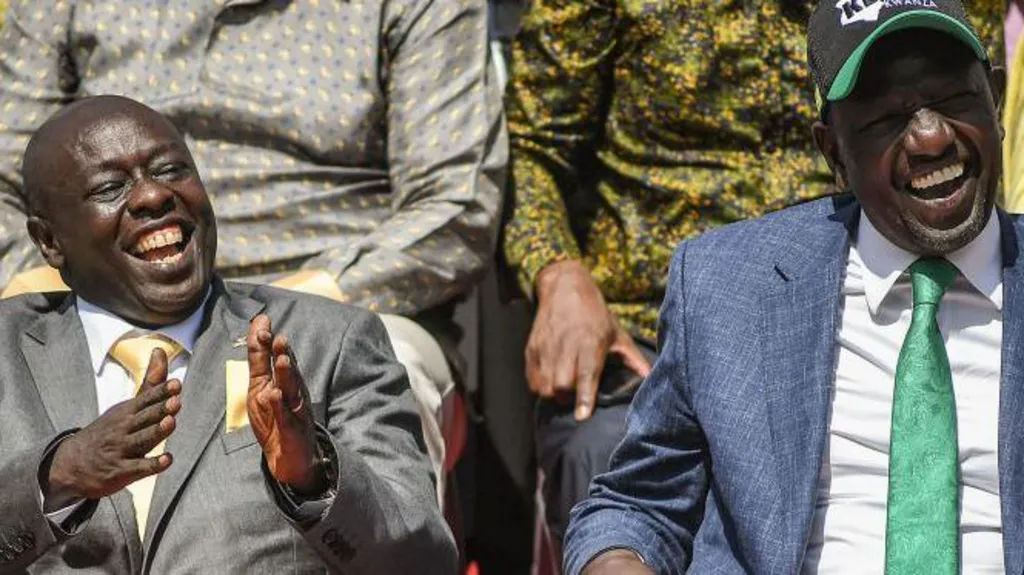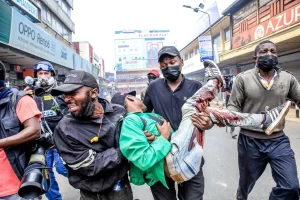How Kenya’s president has fallen out with his deputy
3 min read
Rigathi Gachagua (L) and William Ruto (R) were elected on a joint ticket just two years ago.

Rigathi Gachagua (L) and William Ruto (R) were elected on a joint ticket just two years ago.
In a dramatic turn of events, Kenya’s Deputy President, Rigathi Gachagua, faces potential impeachment as tensions escalate between him and President William Ruto. This political turmoil comes amid accusations that Gachagua has undermined the government, fostered ethnic divisions, and been complicit in the violent protests that rocked the nation in June. Concerns about instability are growing at a time when Kenya is grappling with a serious economic crisis.
Ruto selected Gachagua as his running mate in the 2022 election, where they triumphed over former Prime Minister Raila Odinga in a highly contentious race. Gachagua, hailing from the influential Mount Kenya region, played a pivotal role in rallying support for Ruto. However, the political landscape has shifted dramatically since then, particularly following the recent youth-led protests that pressured Ruto to abandon plans to increase taxes. With members of Odinga’s party now joining the government, Gachagua appears increasingly isolated.
Legislators are now preparing to introduce a motion in parliament calling for Gachagua’s impeachment. Majority Leader Kimani Ichung’wah has confirmed his support, stating, “I have already appended my signature to it.” Efforts by Gachagua’s allies to block the motion in the High Court have been unsuccessful, with reports indicating that nearly 250 lawmakers have already signed in favor of the motion, surpassing the required one-third threshold.
“I was surprised that I was number 242 to sign it and there was still a queue waiting to sign,” remarked legislator Didmus Barasa. Another legislator, Rahim Dawood, commented, “It’s a foregone conclusion; the DP asked for it.” Despite this mounting pressure, Gachagua remains defiant, asserting that he has the backing of the electorate in his home region. “Two hundred people cannot overturn the will of the people,” he stated, signaling his determination to fight back.
For the impeachment motion to succeed, it must garner support from two-thirds of both the National Assembly and the Senate, excluding nominated members. Gachagua’s opponents are optimistic about the motion’s chances, particularly with the backing of Odinga’s party. Nevertheless, Gachagua has indicated that he will not concede easily, suggesting that any push for his removal implicates the president as well.

Ruto has previously vowed to protect Gachagua from political persecution, recalling his own experiences as deputy to former President Uhuru Kenyatta. However, the widening rift between the two has become increasingly visible. Gachagua has notably been absent from significant events, such as airport send-offs for Ruto’s international trips, while Interior Secretary Kithure Kindiki—who is closely aligned with the president—has begun taking on some of Gachagua’s responsibilities.
Kindiki’s rising prominence has fueled speculation that he could be positioning himself as a successor to Gachagua. As a fellow Mount Kenyan, he is garnering support from various legislators who see him as a preferred representative of the region. This shift leaves Gachagua with dwindling political allies, making his position even more precarious.
Adding to Gachagua’s woes, the Directorate of Criminal Investigations (DCI) recently recommended charges against two MPs and several close associates of the deputy president for allegedly inciting and financing the June protests. Gachagua condemned these allegations as a “scheme” to tarnish his reputation and pave the way for his impeachment.
In a parliamentary session, Kindiki—whose ministry oversees the DCI—assured legislators of his neutrality but emphasized the need for accountability. “We are dealing with the aftermath of the attempted overthrow of the constitution of Kenya,” he declared, underscoring the seriousness of the situation.
However, many young activists involved in the protests dismiss claims that Gachagua’s allies were responsible for the unrest, interpreting the impeachment bid as a diversion from broader issues of governance. They argue that if Gachagua is ousted, the president should also be held accountable.
As Ruto prepares to meet with party legislators, he must weigh the political ramifications of taking a stance against Gachagua. For now, the future of the deputy president hinges on the legislative process, with the potential for Ruto to play a decisive role in either bolstering or undermining Gachagua’s position.
In conclusion, the unfolding drama within Kenya’s government highlights deepening political rifts and raises critical questions about stability amid ongoing economic challenges. With Gachagua’s fate uncertain, the coming days will be pivotal in determining the trajectory of this escalating political crisis.